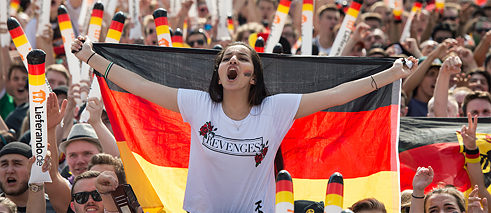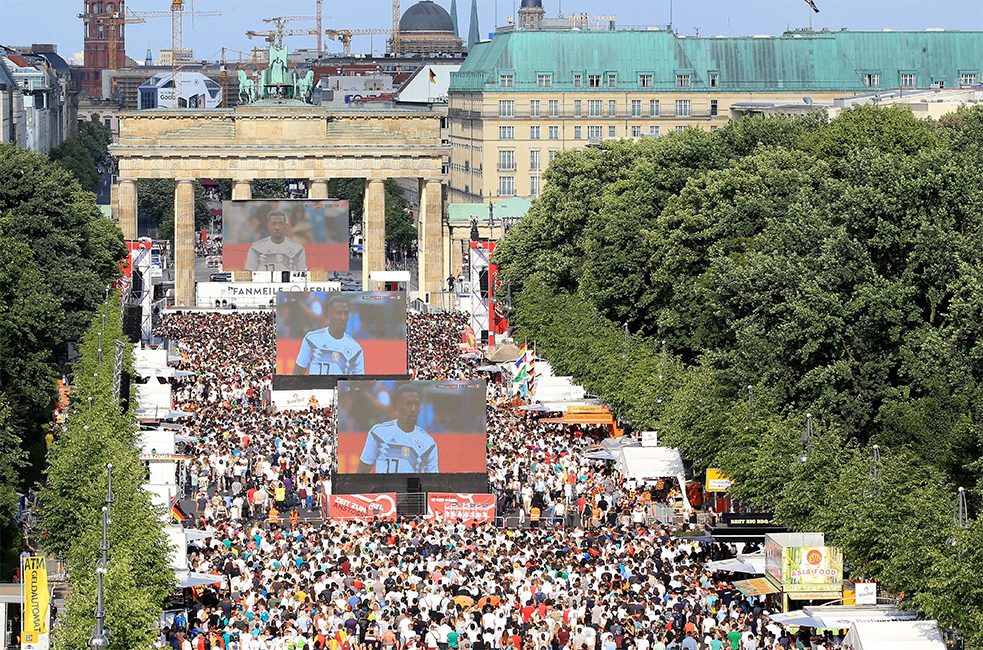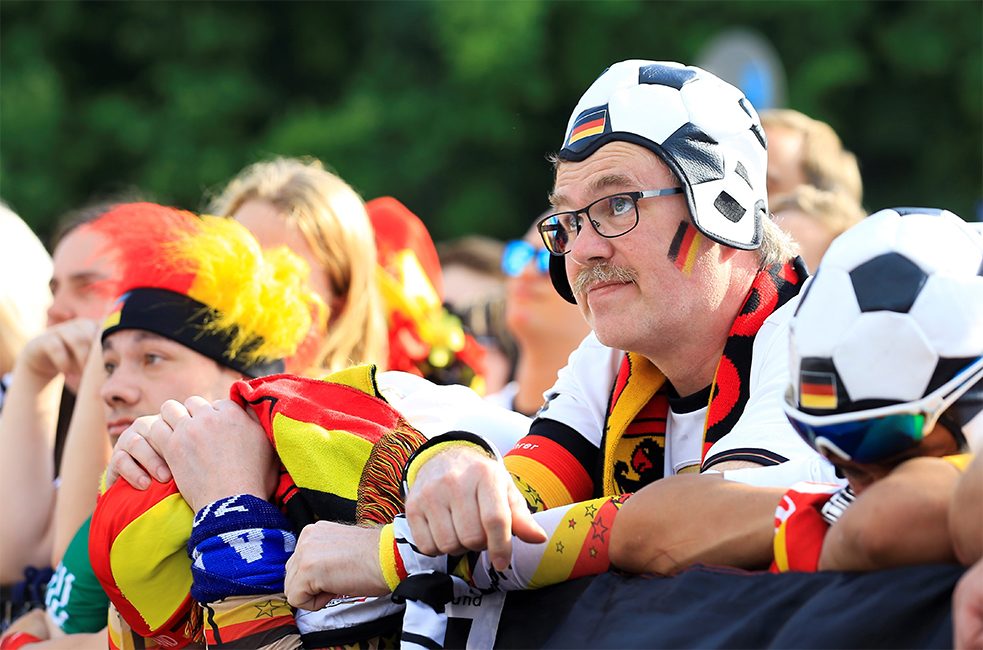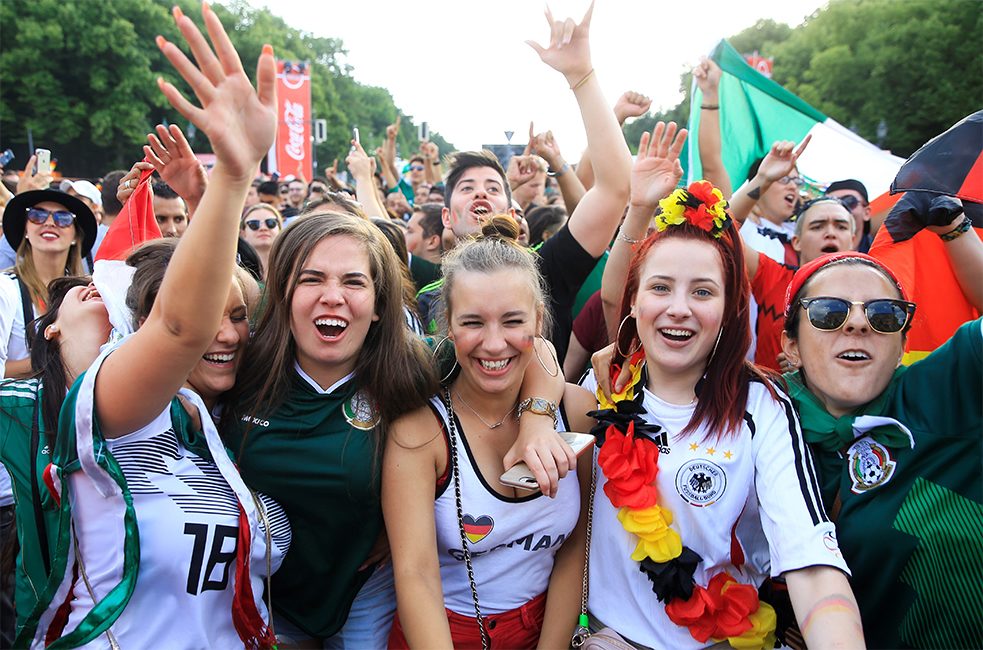Germany’s national colours
Reclaiming the flag, or showing our true colours

After decades of a shadowy existence, the black, red and gold of the German flag have become standards signs of national pride at events like the Football World Cup. But fears are also growing that a new wave of nationalism may emerge from the shadows as well.
June 2018: Tens of thousands of hopeful football supporters gather at Fan Fest Berlin to root for the German national team in its first match at the World Cup in Russia. The crowd in front of Brandenburg Gate is awash in Germany’s national colours. Fans sport caps, scarves, sweatbands, seat cushions and other paraphernalia in black, red and gold, keen to display their allegiance with the national team. Some cars even boast side-mirror covers in the national colours, and flags flutter wildly throughout the country.
 Fan Fest Berlin: Tens of thousands of football fans gathered here to watch the German national team’s opening match at the 2018 World Cup.
| Photo (detail): © picture alliance / Andreas Gora
Wearing the national colours, a matter of course in many other places, is still a relatively recent phenomenon in Germany. The trend started in the summer of 2006, when Germany hosted the Football World Cup. Sociologist Dagmar Schediwy interviewed a lot of people on the street during the “summer fairy tale”: "Most fans reported a kind of national coming-out during the 2006 World Cup. Up to that point, open displays of national pride had been rather frowned upon.” In the decades that followed the Second World War, Germans were reluctant to exhibit any kind of national feeling. Helmut Kohl, German chancellor for many years, reflected this sentiment when he said, “The future lies with Europe, not with individual nation states.”
Fan Fest Berlin: Tens of thousands of football fans gathered here to watch the German national team’s opening match at the 2018 World Cup.
| Photo (detail): © picture alliance / Andreas Gora
Wearing the national colours, a matter of course in many other places, is still a relatively recent phenomenon in Germany. The trend started in the summer of 2006, when Germany hosted the Football World Cup. Sociologist Dagmar Schediwy interviewed a lot of people on the street during the “summer fairy tale”: "Most fans reported a kind of national coming-out during the 2006 World Cup. Up to that point, open displays of national pride had been rather frowned upon.” In the decades that followed the Second World War, Germans were reluctant to exhibit any kind of national feeling. Helmut Kohl, German chancellor for many years, reflected this sentiment when he said, “The future lies with Europe, not with individual nation states.”
Rebelling against the prevailing understanding of history
The positive media coverage of the national colours’ 2006 comeback ended this restrained approach, and masses of fans donned the black, red and gold with increasing confidence. “Many saw it as a liberation,” sociologist Schediwy recalls. Younger fans in particular wanted to celebrate as a nation without the crushing weight of Germany’s national-socialist patriotic past. To them, German flags and the national colours painted on faces or emblazoned on clothing symbolized nothing more than the feeling of solidarity with their football team other countries take for granted.
 Whether as face paint, on a T-shirt, or as a handheld flag: Since 2006, most football fans wouldn’t dream of cheering on their team without the black, red and gold.
| Photo (detail): © picture alliance / Abdulhamid Hosbas / AA
Flying the flag and wearing the national colours has since become the norm in Germany, though there has been some backlash. Many denounced this new trend in the run up to the 2018 World Cup, which experts attribute in part to the emergence of right-wing populist movements. Demonstrators at rallies organised by the "Patriotic Europeans against the Islamization of the West" (Pegida) alliance and the "Alternative for Germany" (AfD) party, which won some seats in the German Bundestag in 2017, enthusiastically wave the German flag along with their party flag. The AfD fan shop sells stickers and posters that feature the black, red and gold.
Whether as face paint, on a T-shirt, or as a handheld flag: Since 2006, most football fans wouldn’t dream of cheering on their team without the black, red and gold.
| Photo (detail): © picture alliance / Abdulhamid Hosbas / AA
Flying the flag and wearing the national colours has since become the norm in Germany, though there has been some backlash. Many denounced this new trend in the run up to the 2018 World Cup, which experts attribute in part to the emergence of right-wing populist movements. Demonstrators at rallies organised by the "Patriotic Europeans against the Islamization of the West" (Pegida) alliance and the "Alternative for Germany" (AfD) party, which won some seats in the German Bundestag in 2017, enthusiastically wave the German flag along with their party flag. The AfD fan shop sells stickers and posters that feature the black, red and gold.
Psychologist Stephan Grünewald has observed that some fans choose “(flag) desertion” in response to the AfD’s and Pegida’s flag-brandishing proponents. He says that the black, red and gold are regaining a nationalistic charge many prefer to distance themselves from: “We would rather leave the flag in the cellar to ensure we don’t stir up nationalist sentiments. Some are worried about being tarred with the AfD’s nationalist brush.” In Berlin daily newspaper, the taz, journalist Lin Hirse wrote: “With the rise of Pegida, the ambiguities around the colour brown are even more firmly stuck to German flag like glue.”
Showing our national colours
The debate on what Germany’s national colours symbolize is in full swing. In June 2018, Vice President of the German Bundestag Claudia Roth warned of an emerging wave of nationalism. And while she didn’t want to forbid anyone from flying the flag, the Green politician said, "I think as Germans, we would do well to show restraint with nationalistic, self-congratulatory displays.” She emphasised that the AfD in particular were instrumentalising the German flag to signal exclusion. Political scientist Stefan Marschall has a very different take on the issue. He is confident that keeping the German flag flying in a wide range of contexts could prevent it from being "appropriated and exploited for other ideas".
 For many football fans, wearing Germany’s national colours is just part of the fun and has nothing to do with xenophobia or exclusion - but criticism is growing.
| Photo (detail): © picture alliance / Abdulhamid Hosbas / AA
The sense of lightness and ease from the 2006 World Cup has vanished, and we can no longer take such a relaxed, carefree approach to national symbols– for the most part at least. Besides, many German football fans also have other favourites among the nations participating in this year’s World Cup. This multi-cultural Germany is evident in importer Promex’s sales figures. The company reports that while the German flag is the top seller at 27 percent, scarves in the national colours of countries like Switzerland, Russia, Poland, Iceland and France are also in demand, and one in fifty customers apparently plans to cheer on far-off Australia.
For many football fans, wearing Germany’s national colours is just part of the fun and has nothing to do with xenophobia or exclusion - but criticism is growing.
| Photo (detail): © picture alliance / Abdulhamid Hosbas / AA
The sense of lightness and ease from the 2006 World Cup has vanished, and we can no longer take such a relaxed, carefree approach to national symbols– for the most part at least. Besides, many German football fans also have other favourites among the nations participating in this year’s World Cup. This multi-cultural Germany is evident in importer Promex’s sales figures. The company reports that while the German flag is the top seller at 27 percent, scarves in the national colours of countries like Switzerland, Russia, Poland, Iceland and France are also in demand, and one in fifty customers apparently plans to cheer on far-off Australia.